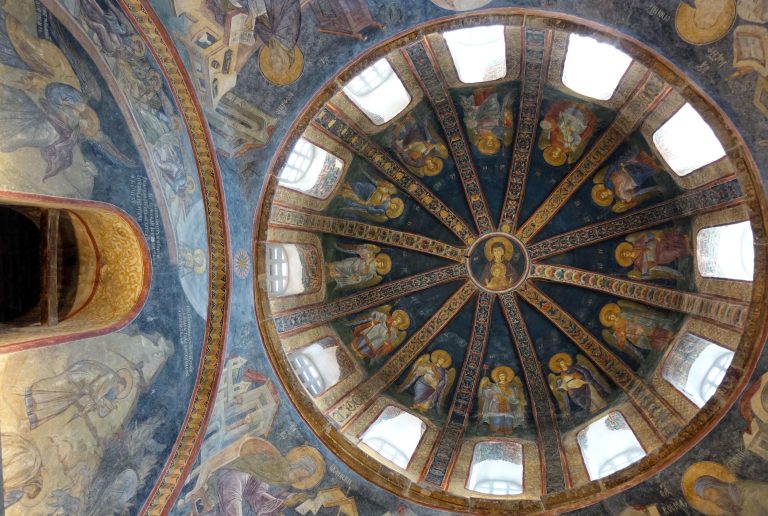ISTANBUL — When the 11th-century Church of the Holy Sepulchre was ordered to be converted into a mosque in 2020, many feared damage to its ornate interior, which houses some of the world’s finest late Byzantine mosaics and frescoes. After four tense years of waiting while the building was closed for restoration, it reopened on May 6 as the Kariye Mosque, with its precious Christian artworks (except for a few pieces in the central nave, which is reserved for men’s prayer halls and off-limits to non-Muslims and women) once again open to the public.
Turkish President Recep Tayyip Erdogan has pushed to reopen Chora and the world-famous Hagia Sophia to Muslim prayers after decades as museums. Erdogan has hailed the move as a victory for Muslims around the world and used the Byzantine Empire to disparage his political opponents. The Byzantine Empire was a continuation of the Roman Empire, ruling a vast territory from 330 to 1453, when its capital, Constantinople (formerly Byzantium, now Istanbul), fell to the Ottoman Empire.

“Everything in Istanbul has a Byzantine undertone — you can’t understand the city without it — but Byzantium is not always seen as part of Istanbul’s story,” Sedat Bornovalı, an art historian, associate professor of architecture at Istanbul’s Nisantasi University and former president of the Istanbul Tour Guides Association, told reporters. Allergic.
Over the centuries, much of the Byzantine Empire’s historic splendor in Istanbul has vanished, while others have been repurposed, forgotten, or worse. The historic walls were badly restored in the 1980s. A luxury hotel was built on the site of the Great Palace of Constantinople. A few years ago, the ruins of the Church of St. Polyeuctus, once a rival of Hagia Sophia in grandeur, were nearly swallowed up by trash-strewn weeds.


Today, St. Polyuktus, the city walls, the Valens Aqueduct and other Byzantine sites are being restored as part of a series of cultural heritage projects led by the opposition-controlled Istanbul Metropolitan Municipality since taking office in 2019, promising a more comprehensive representation of the city’s past. But the municipality has no authority over Istanbul’s many Byzantine churches-turned-Ottoman mosques, such as the Chora Mosque and Hagia Sophia, which are overseen by the Directorate of Religious Affairs if they are still in use, or by the General Directorate of Foundations if they are not.
The Studios Monastery was founded in the fifth century AD and is considered by some to be the most important monastic foundation of the Byzantine period and one of the most watched by heritage experts.
“The plan of the foundation council is to ‘restore’ the building as a mosque, which would mean a very large-scale restoration that would result in the loss of its original features,” Professor Engin Akyürek, director of Istanbul Koç University’s Sevgi Gönül Center for Byzantine Studies, told reporters. Allergic.
Information boards on the hoardings around the site almost exclusively refer to the project as the Imrahor Ilyas Bey Mosque, as it became known after the Ottoman conquest, while the monastery is only briefly mentioned.

A similar flattening of layers of history has occurred at many churches-turned-mosques, as well as at the Porphyrogenitus Palace (now known as Tekfur Palace), built within Istanbul’s land walls in the late 13th century. Under the restoration of the former Istanbul municipality, the palace “underwent a rather ideological repurposing, as if it had not existed before the Ottomans,” Bornovalı said. “Turning it into a museum, showing [Ottoman] The tile wasn’t even from there, it wasn’t a good choice.”
Ideological considerations have long influenced excavation, research, preservation, exhibition and restoration efforts in Turkey. When the Turkish Republic was established in 1923, founding president Mustafa Kemal Ataturk and other leaders “proposed a Turkish historical argument that skipped all Byzantine history,” Barış Altan, a Turkish cultural heritage expert, told reporters. Allergic.
“They tried to find their roots in the Sumerians and Hittites and establish the idea that the Turks had lived in Anatolia since ancient times,” said Altan, who is currently an academic at the Department of Architectural Conservation at the Brandenburg University of Technology in Germany.

While the study of Byzantium was largely left to Western scholars in the early 20th century, the focus of the Erdogan era has been on restoring the Ottoman Empire’s past glory. However, Altan believes that claims of systematic neglect of the Byzantine legacy are exaggerated, pointing to ongoing excavations of Byzantine sites across Turkey and the growing number of young Turkish scholars working in the field.
Aside from highly politicized symbols like the Hagia Sophia, he said, the problems associated with Byzantine sites are more likely due to issues common to all cultural heritage in Turkey: limited funding, a lack of strategic planning among multiple, sometimes antagonistic stakeholders, and a “tourist understanding of culture” that often results in destructive interventions designed to make historic sites more attractive to revenue-generating tourists.
National or local government agencies that fund restoration projects sometimes also exert pressure to expedite “work that actually takes time and patience,” Akyurek added. “They are always eager to have their work seen by the public.”

